The Cornell Lab Bird Academy › Discussion Groups › Nature Journaling and Field Sketching › Jump Right in!
-

-
1. Drawing from the photo gave me time to look many times at proportions and details of a perfectly posed subject. Nothing came easy, but the proportions were very difficult and the expression on this cute warbler's face was very difficult to capture. 2. I would not have noticed the way the beak meets the head, the detail of the feet gripping the branch with the long "fingers" extending below the branch, the wing coverts and many other details. Nature journaling gets one to observe these details, but, if one is drawing a warbler in nature and not from a photo, the observation time will be too short for me to get that sort of detail.

-
1. Intimidating because it’s my first attempt to do something like this. The attempt was challenging. But I enjoyed it. 2. The proportion of the bird’s body, and details of the branches and the leaves. 3. Absolutely. Nature includes the bird’s environment.
-
I totally agree with your answers! :). I am right there with you
-
-
 Drawing from the photo was great! You could enlarge the parts when you wanted to observe details. However, as a result, my proportion was off.
I hadn’t used a water brush before. Have to have extra water for rinsing so paints chips don’t get contaminated.
Also must remember to keep white areas white.
Drawing from the photo was great! You could enlarge the parts when you wanted to observe details. However, as a result, my proportion was off.
I hadn’t used a water brush before. Have to have extra water for rinsing so paints chips don’t get contaminated.
Also must remember to keep white areas white. -
When drawing, even when it's from a photo, you notice things that you didn't notice just glancing at the photo. I am encouraged by that because it occurs to me that I have a several years worth of photos I've taken during my travels that I can use for drawings, which will be an excellent way to document and re-examine those places and visits.

-
I spent about 15 minutes doing this sketch, I have spent most of my time in nature taking photos, this course on my first day, is already quite an eye opener. Spending some time drawing this bird allowed me to notice more identifying details and I like making notes. I can identify with Elois, drawing from photos is good in some ways, but it is hard to breath life into the sketch.

-
I was ok about trying to draw from the photo and to prevent it from being too challenging I did not try to make it look like a photo but to make it simple and recognizable as a bird on a limb. i am happy that in my mind when I see my drawing I remember what was in the photo that I did not include in my drawing.
-

-
Drawing from a photo is good, but my photo drawings always look stiff to me - sort of like drawing from a stuffed bird. I like to do several “gesture” drawing from a living thing even though it always looks messy and sketchy. I haven’t been drawing much recently and I’m looking forward to the discipline of a regular effort. I also enjoyed looking at other participants drawings. This is a lot of fun!
-

-
 drawings allow us to pay closer attention to details. When I'm photographing birds, I'm more worried about exposure, lighting, and composition. With drawing, I'm looking at the details on my subject.
drawings allow us to pay closer attention to details. When I'm photographing birds, I'm more worried about exposure, lighting, and composition. With drawing, I'm looking at the details on my subject. -
 Sitting in the VW dealership as they update my bug's software. I kept seeing more greens and browns as I looked at the photo. I also noticed how the bird's toes curl around the branch. It also looks like it's smiling a bit when you look at its beak. I may go back and spend more time with it when I don't feel like there's an audience watching me here in the waiting room.
Sitting in the VW dealership as they update my bug's software. I kept seeing more greens and browns as I looked at the photo. I also noticed how the bird's toes curl around the branch. It also looks like it's smiling a bit when you look at its beak. I may go back and spend more time with it when I don't feel like there's an audience watching me here in the waiting room. -
 A quick, rough, warm-up sketch on scrap paper. Now I must be brave and crack open the sketchbook!
A quick, rough, warm-up sketch on scrap paper. Now I must be brave and crack open the sketchbook! -
I finally sat myself down and drew the yellow warbler. I only spent about 40 minutes and thought about going back and working on it. Definite room for improvement. I like the process of looking at the detail as I draw. And the feeling of immersion is meditative. I like macro photography for the same reasons. I’m anxious to move on and so will not return to the warbler now!
 I
I -
- I drew a bird standing on a limb. It definitely looks like a bird but not as nice as a rogervtory Peterson It was not challenging cause I drew like I always bit I’m hoping to do a whole lot better after this class.
- i think I noticed every
-

-
I am not brand new to drawing, but have much to learn. Drawing from a photo made it easy to focus on detail. I imagine drawing birds out in the field would be challenging with all their twitchy movements. Much harder to capture their shapes and details. I think I'll need to learn to make more general shapes to start and then fill in detail later. I have a tendency to make some shapes and do detail as I go, but I am guessing that is not the best way to do it.
-

-

-
I think I'm replying to myself, but after I uploaded there was no other place to write. I'm a VERY late joiner. I promised myself to finish the Spring Bird course before I started, and it took me much longer than I anticipated. As for the bird picture, I read Drawing from the Right Side of the Brain many years ago and that's the sum of my experience. I don't have my materials yet, so I used what was on hand--a number 2 pencil and colored pencils. The image is brighter "in person." Of course it would be absolutely impossible to draw a bird without a picture, and I learned so much more about the yellow warbler by drawing it. "I DO and I learn." and "from my fingers to my brain" come to mind.
-
-
 This was more difficult than I expected. I think I should have done better!
The general shapes were easy enough but I don't think I got the colouring very well, and trying to fix it would only make it worse.
I might not have noticed the extent of the lichen if I hadn't drawn it.
It took longer than expected so I can't imagine being able to do it outside with a live bird!
This was more difficult than I expected. I think I should have done better!
The general shapes were easy enough but I don't think I got the colouring very well, and trying to fix it would only make it worse.
I might not have noticed the extent of the lichen if I hadn't drawn it.
It took longer than expected so I can't imagine being able to do it outside with a live bird!
-
I love how you caught little details like curve/layers of its feathers as well as the light variants on the branch, legs and body of the warbler.
-
-
 The photo makes it easier to draw more details of the Yellow Warbler then being in the field getting a quick look at the bird. That is why it is good to get a photo of the bird or object when you are outside and then complete the drawing afterwards. I found it challenging to draw the details of the wings-primaries, secondaries and tertials. The body proportions-head, bill, and back and belly were challenging too. It was easier to revise and adjust the sizing and fan-like shape of the wings with a photo. I also noticed how the wings are aligned and the tarsus and toes grasping onto the branch was much more apparent. If I was doing a nature journal and saw the Yellow Warbler, I would miss these details.
The photo makes it easier to draw more details of the Yellow Warbler then being in the field getting a quick look at the bird. That is why it is good to get a photo of the bird or object when you are outside and then complete the drawing afterwards. I found it challenging to draw the details of the wings-primaries, secondaries and tertials. The body proportions-head, bill, and back and belly were challenging too. It was easier to revise and adjust the sizing and fan-like shape of the wings with a photo. I also noticed how the wings are aligned and the tarsus and toes grasping onto the branch was much more apparent. If I was doing a nature journal and saw the Yellow Warbler, I would miss these details. -
Drawing from a photo gives you the luxury of taking your time. i really want to use the water colors and I find getting detail a challenge. Using micron pen is helpful and I like this combination. I really noticed the textures in the photo, soft feathers, glossy leaves , rough bark...I'd like to be able to capture that feeling.

-
 I prefer drawing from life so I was resistant at first to work from a photo, but birds don't sit still for long, so photos are often the only option. It was challenging to get the proportions/anatomy to look right, but once I had the pencil drawing done, (the hard part) inking and coloring the sketch was very enjoyable.
I prefer drawing from life so I was resistant at first to work from a photo, but birds don't sit still for long, so photos are often the only option. It was challenging to get the proportions/anatomy to look right, but once I had the pencil drawing done, (the hard part) inking and coloring the sketch was very enjoyable. -
I love your drawing. You captured all the identifying features of this bird exquisitely.
-
-
 Drawing can bring back memories of that specific time, weather, song of the bird, etc. Photos can quickly capture a fast moving critter or insect
Drawing can bring back memories of that specific time, weather, song of the bird, etc. Photos can quickly capture a fast moving critter or insect -
 Much easier to capture angles and details from a still photo. The brown lines on chest might have gone unnoticed or seen as black/grey like rest of markings. I also might not have noticed placement of pin dot in eye that may hint at direction of the light source. Also, the wrap of the claw around the branch might not have come off so well if not in photo, maybe with more practice and understanding leg and claw/talon, grasp angles.
Much easier to capture angles and details from a still photo. The brown lines on chest might have gone unnoticed or seen as black/grey like rest of markings. I also might not have noticed placement of pin dot in eye that may hint at direction of the light source. Also, the wrap of the claw around the branch might not have come off so well if not in photo, maybe with more practice and understanding leg and claw/talon, grasp angles.
Read More:
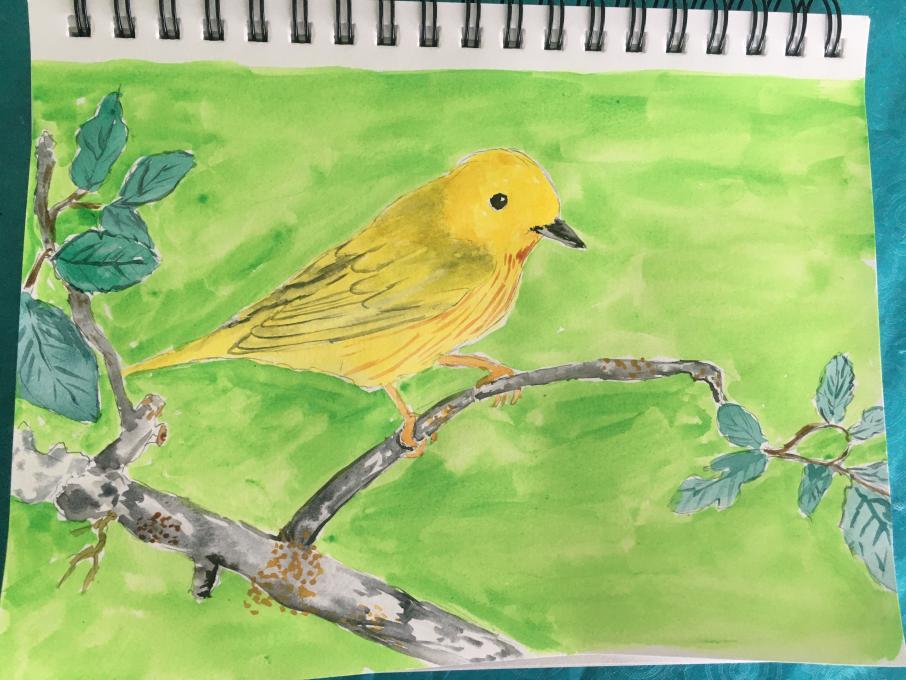
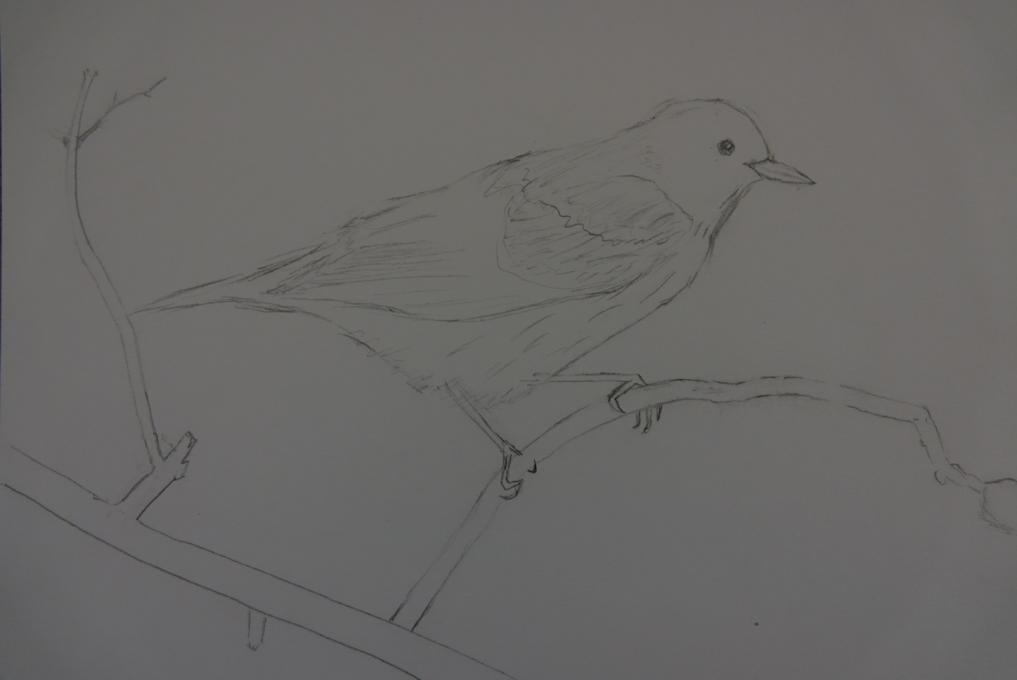
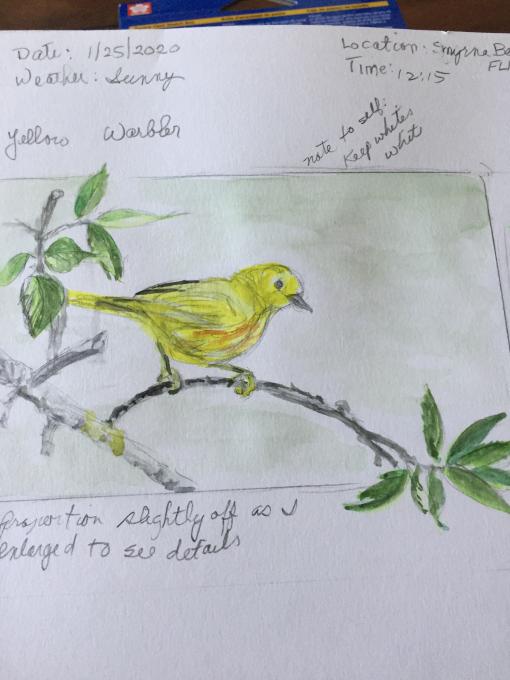 Drawing from the photo was great! You could enlarge the parts when you wanted to observe details. However, as a result, my proportion was off.
I hadn’t used a water brush before. Have to have extra water for rinsing so paints chips don’t get contaminated.
Also must remember to keep white areas white.
Drawing from the photo was great! You could enlarge the parts when you wanted to observe details. However, as a result, my proportion was off.
I hadn’t used a water brush before. Have to have extra water for rinsing so paints chips don’t get contaminated.
Also must remember to keep white areas white. 
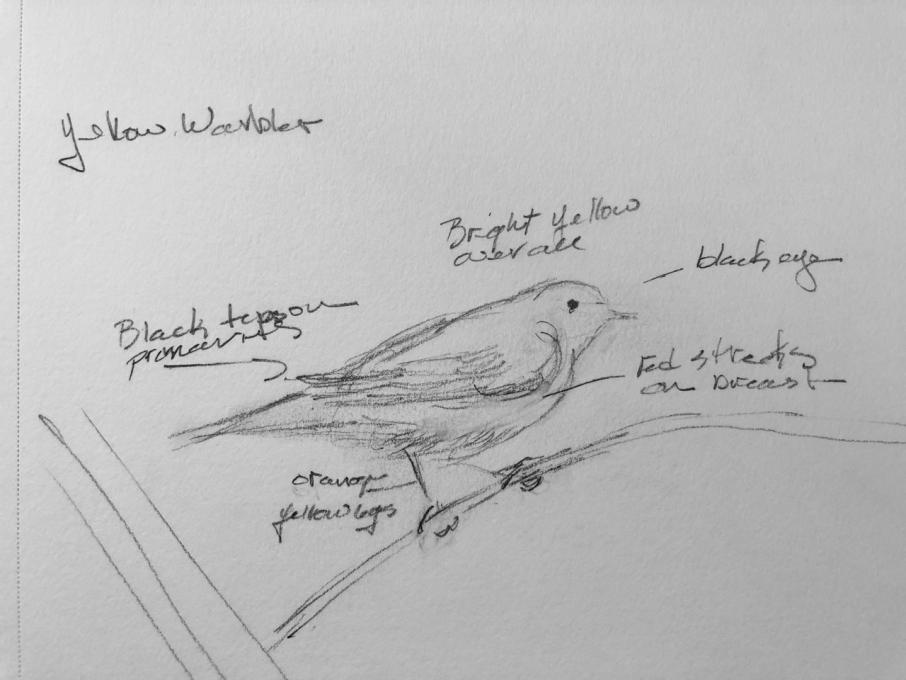
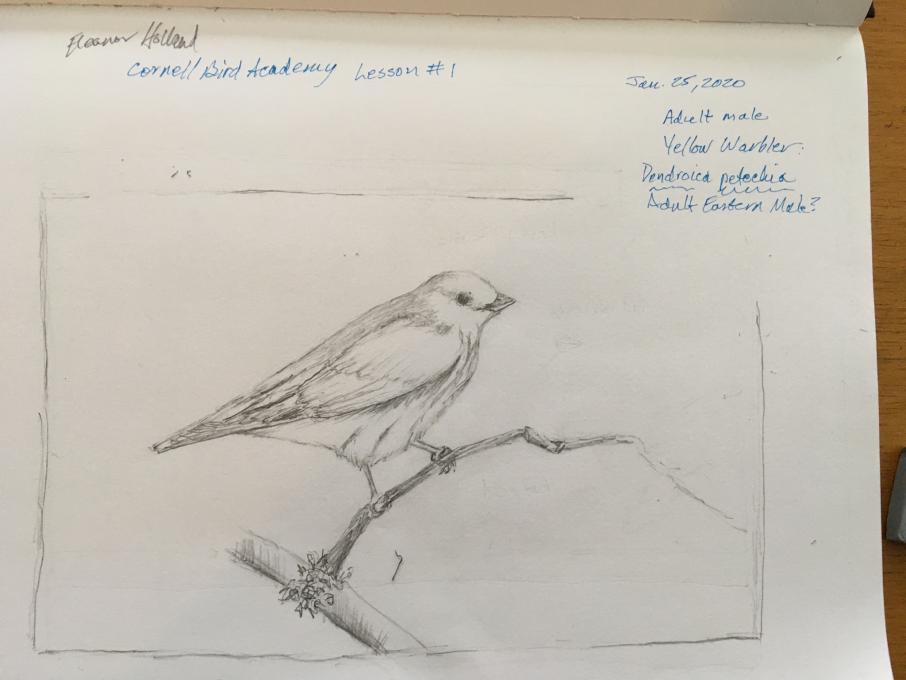
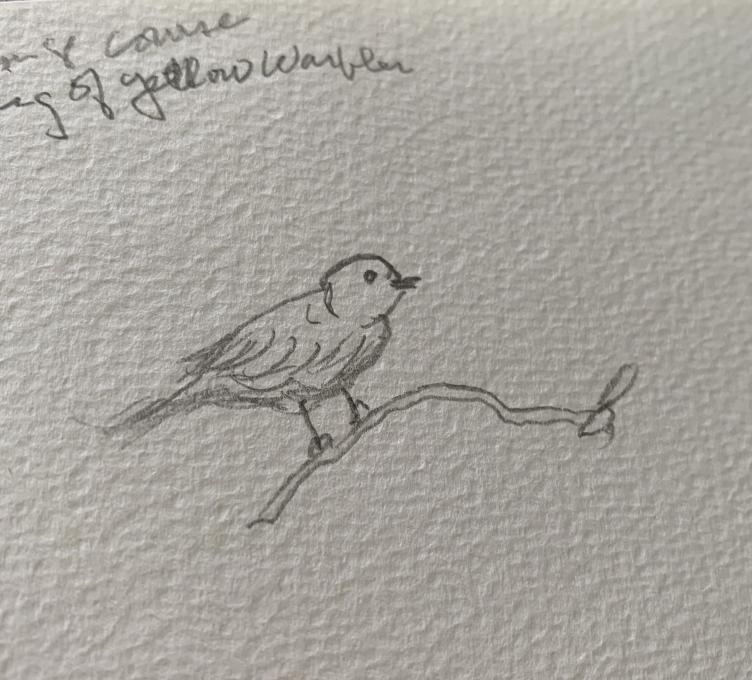
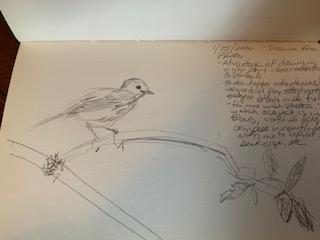 drawings allow us to pay closer attention to details. When I'm photographing birds, I'm more worried about exposure, lighting, and composition. With drawing, I'm looking at the details on my subject.
drawings allow us to pay closer attention to details. When I'm photographing birds, I'm more worried about exposure, lighting, and composition. With drawing, I'm looking at the details on my subject. 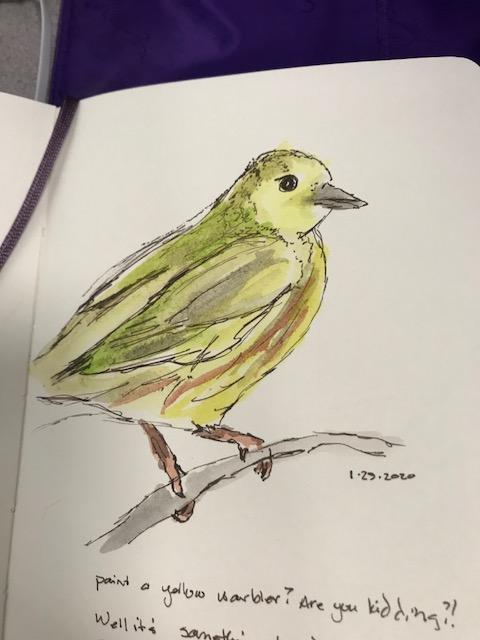 Sitting in the VW dealership as they update my bug's software. I kept seeing more greens and browns as I looked at the photo. I also noticed how the bird's toes curl around the branch. It also looks like it's smiling a bit when you look at its beak. I may go back and spend more time with it when I don't feel like there's an audience watching me here in the waiting room.
Sitting in the VW dealership as they update my bug's software. I kept seeing more greens and browns as I looked at the photo. I also noticed how the bird's toes curl around the branch. It also looks like it's smiling a bit when you look at its beak. I may go back and spend more time with it when I don't feel like there's an audience watching me here in the waiting room. 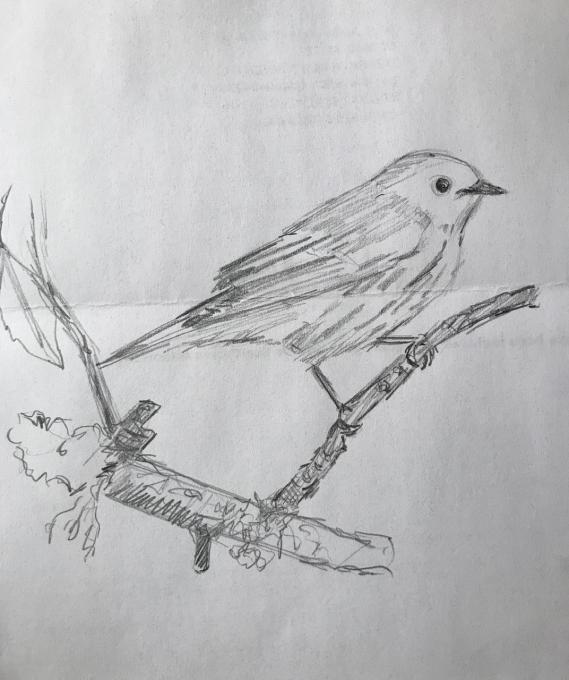 A quick, rough, warm-up sketch on scrap paper. Now I must be brave and crack open the sketchbook!
A quick, rough, warm-up sketch on scrap paper. Now I must be brave and crack open the sketchbook! 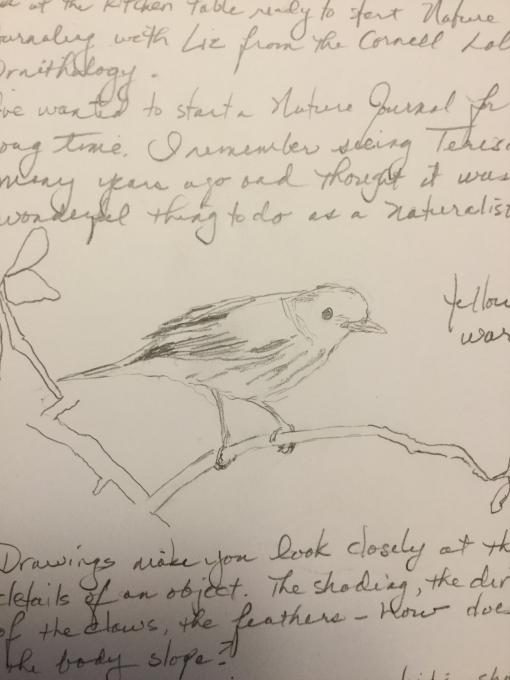 I
I 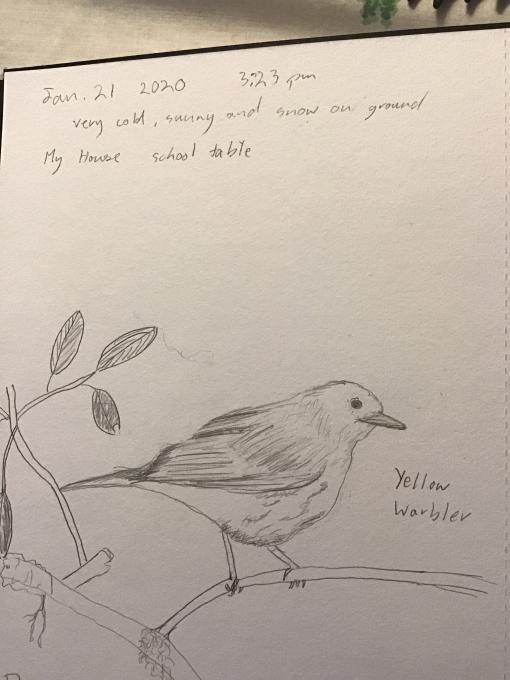
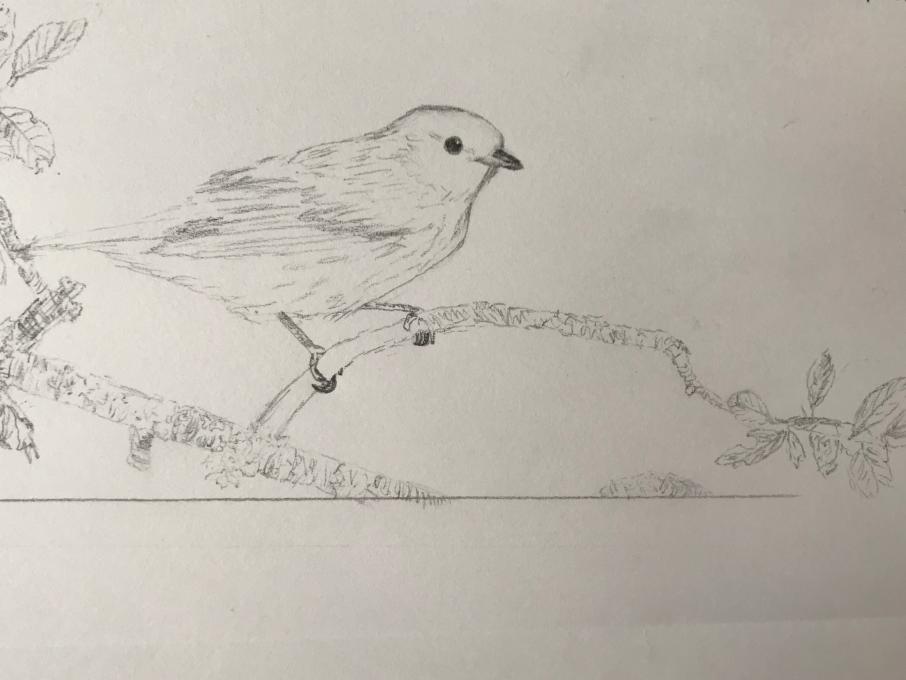
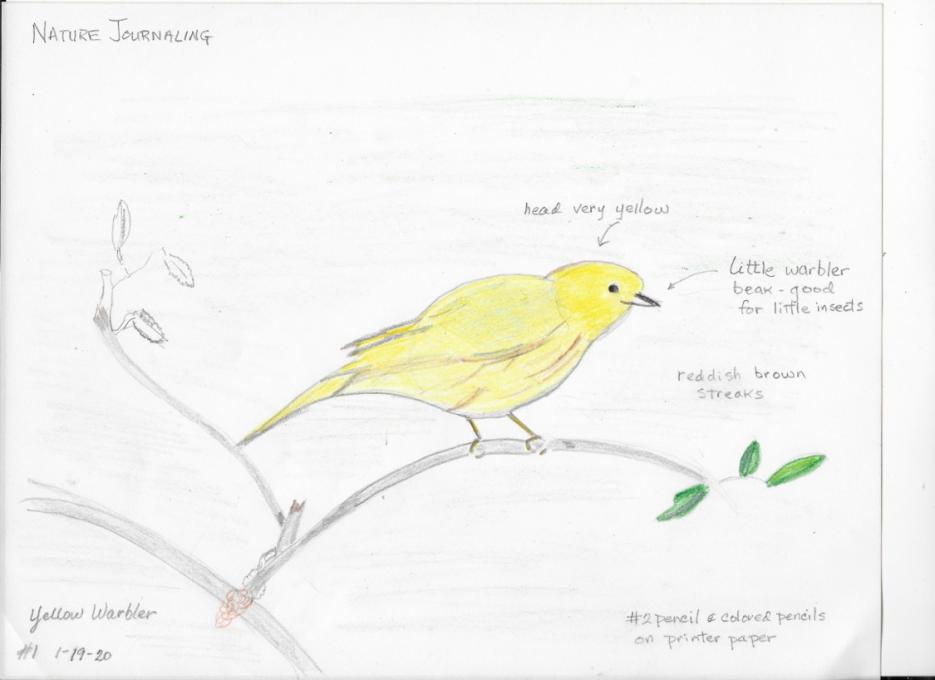
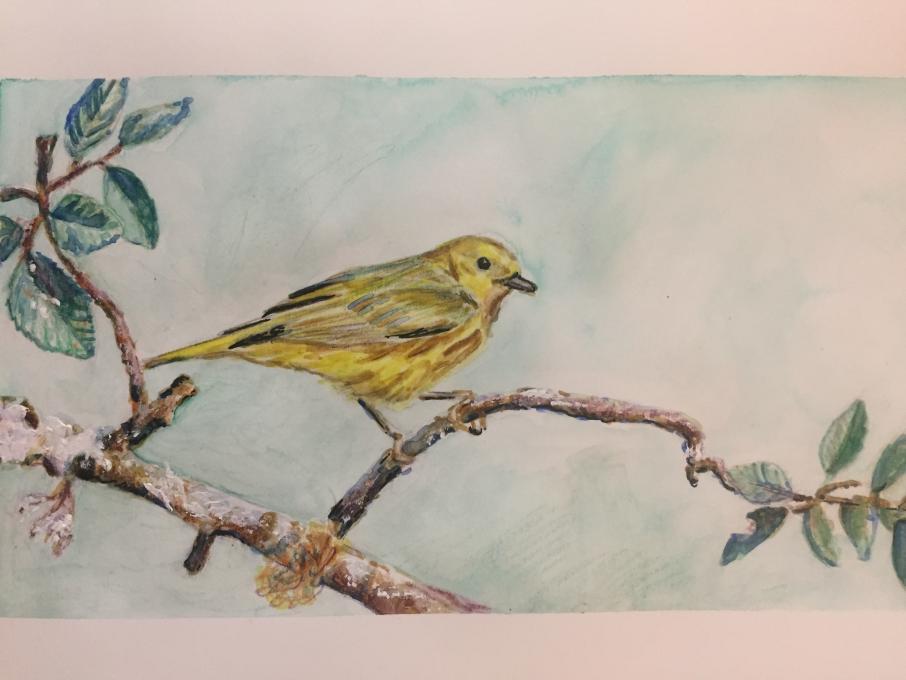 This was more difficult than I expected. I think I should have done better!
The general shapes were easy enough but I don't think I got the colouring very well, and trying to fix it would only make it worse.
I might not have noticed the extent of the lichen if I hadn't drawn it.
It took longer than expected so I can't imagine being able to do it outside with a live bird!
This was more difficult than I expected. I think I should have done better!
The general shapes were easy enough but I don't think I got the colouring very well, and trying to fix it would only make it worse.
I might not have noticed the extent of the lichen if I hadn't drawn it.
It took longer than expected so I can't imagine being able to do it outside with a live bird!
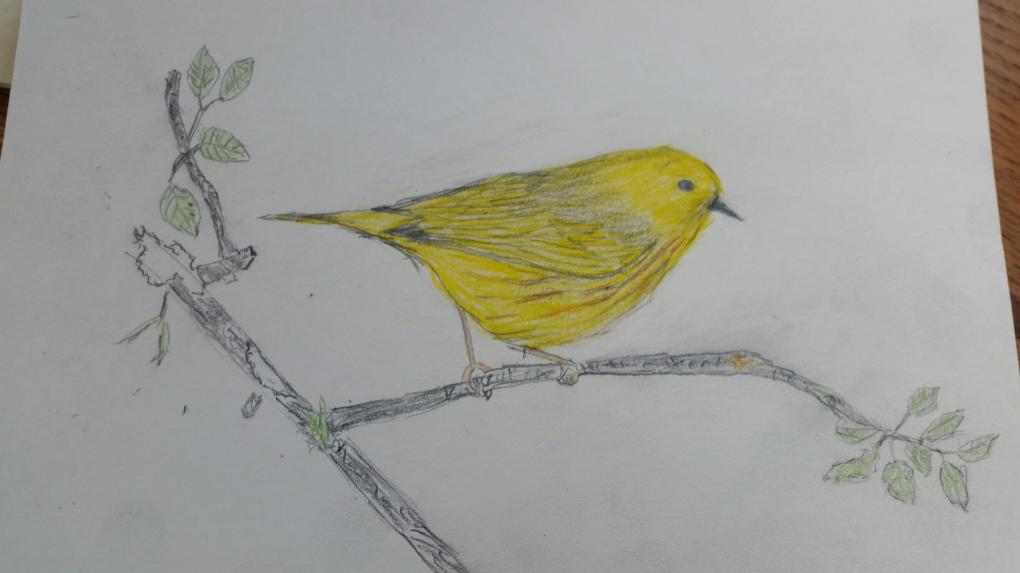 The photo makes it easier to draw more details of the Yellow Warbler then being in the field getting a quick look at the bird. That is why it is good to get a photo of the bird or object when you are outside and then complete the drawing afterwards. I found it challenging to draw the details of the wings-primaries, secondaries and tertials. The body proportions-head, bill, and back and belly were challenging too. It was easier to revise and adjust the sizing and fan-like shape of the wings with a photo. I also noticed how the wings are aligned and the tarsus and toes grasping onto the branch was much more apparent. If I was doing a nature journal and saw the Yellow Warbler, I would miss these details.
The photo makes it easier to draw more details of the Yellow Warbler then being in the field getting a quick look at the bird. That is why it is good to get a photo of the bird or object when you are outside and then complete the drawing afterwards. I found it challenging to draw the details of the wings-primaries, secondaries and tertials. The body proportions-head, bill, and back and belly were challenging too. It was easier to revise and adjust the sizing and fan-like shape of the wings with a photo. I also noticed how the wings are aligned and the tarsus and toes grasping onto the branch was much more apparent. If I was doing a nature journal and saw the Yellow Warbler, I would miss these details. 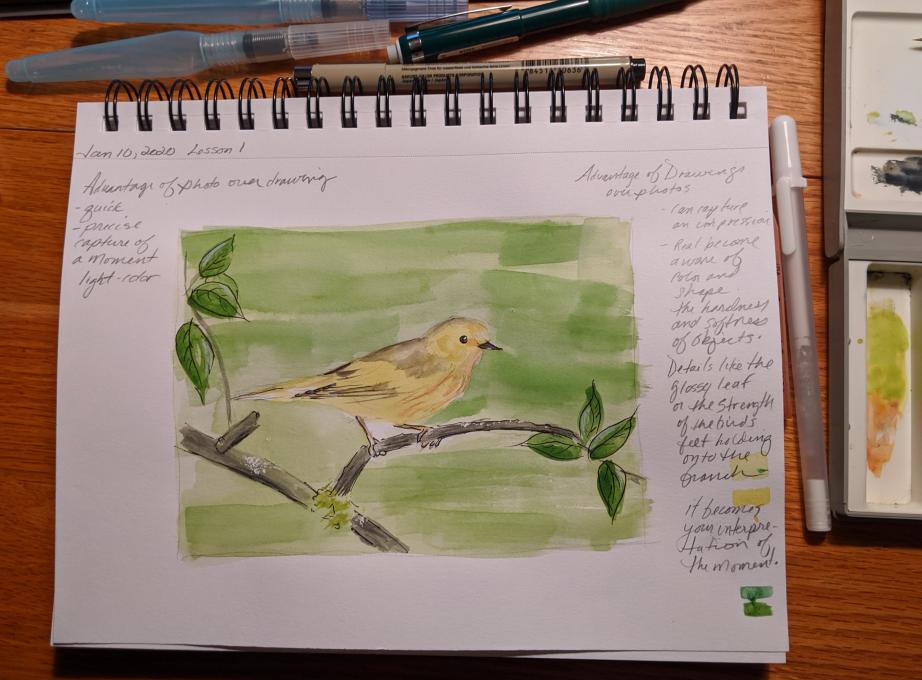
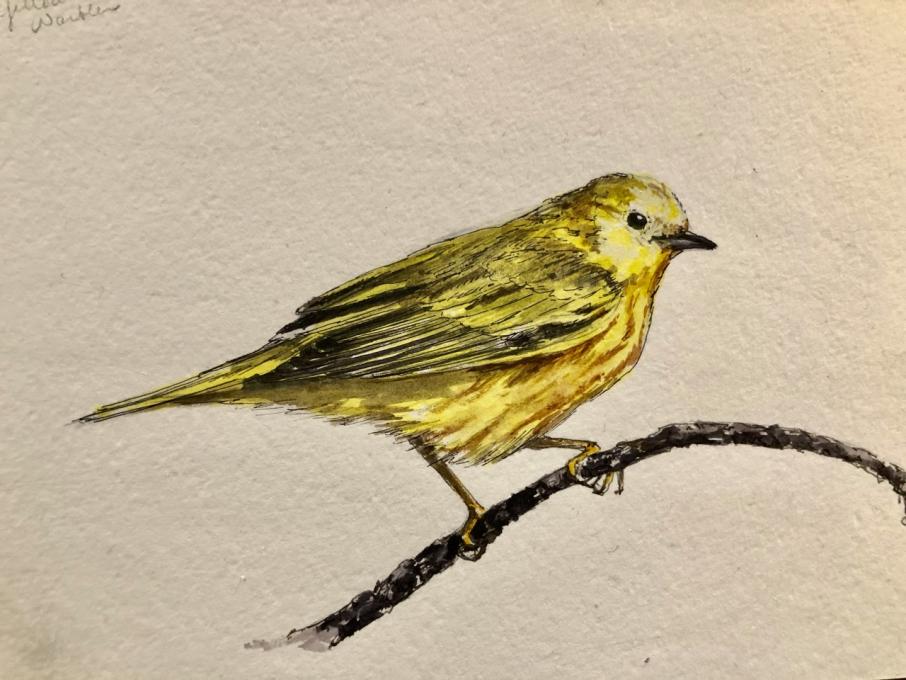 I prefer drawing from life so I was resistant at first to work from a photo, but birds don't sit still for long, so photos are often the only option. It was challenging to get the proportions/anatomy to look right, but once I had the pencil drawing done, (the hard part) inking and coloring the sketch was very enjoyable.
I prefer drawing from life so I was resistant at first to work from a photo, but birds don't sit still for long, so photos are often the only option. It was challenging to get the proportions/anatomy to look right, but once I had the pencil drawing done, (the hard part) inking and coloring the sketch was very enjoyable. 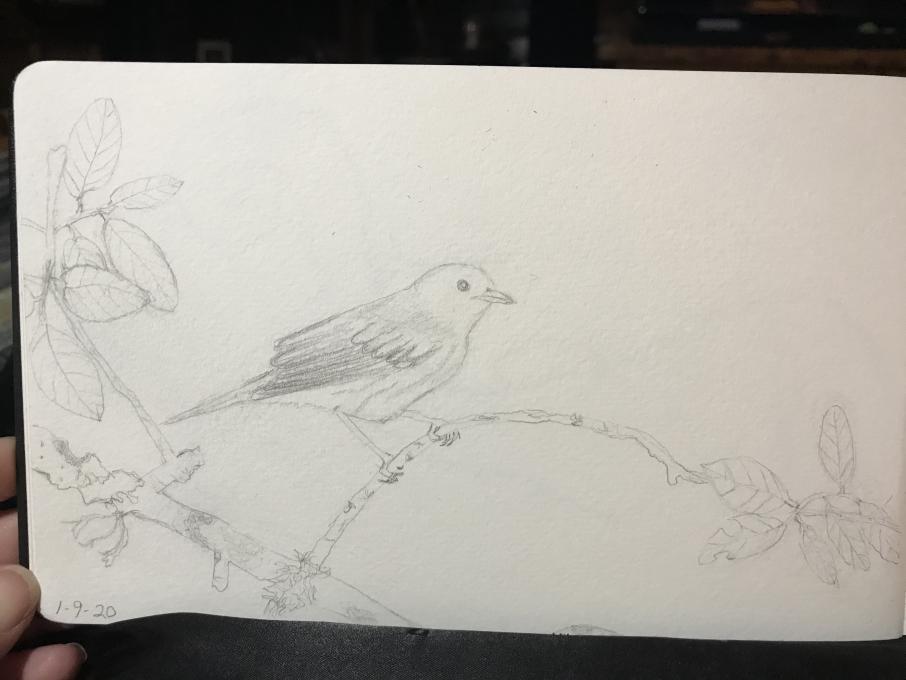 Drawing can bring back memories of that specific time, weather, song of the bird, etc. Photos can quickly capture a fast moving critter or insect
Drawing can bring back memories of that specific time, weather, song of the bird, etc. Photos can quickly capture a fast moving critter or insect 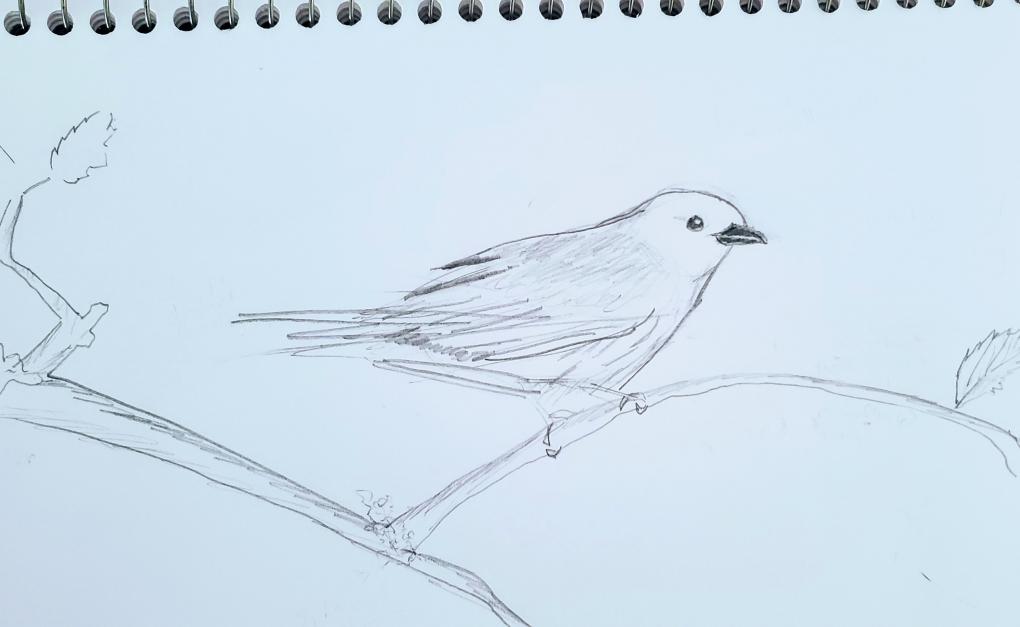 Much easier to capture angles and details from a still photo. The brown lines on chest might have gone unnoticed or seen as black/grey like rest of markings. I also might not have noticed placement of pin dot in eye that may hint at direction of the light source. Also, the wrap of the claw around the branch might not have come off so well if not in photo, maybe with more practice and understanding leg and claw/talon, grasp angles.
Much easier to capture angles and details from a still photo. The brown lines on chest might have gone unnoticed or seen as black/grey like rest of markings. I also might not have noticed placement of pin dot in eye that may hint at direction of the light source. Also, the wrap of the claw around the branch might not have come off so well if not in photo, maybe with more practice and understanding leg and claw/talon, grasp angles.